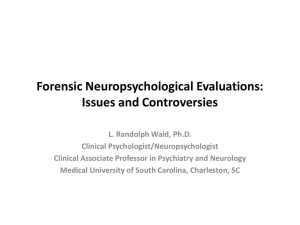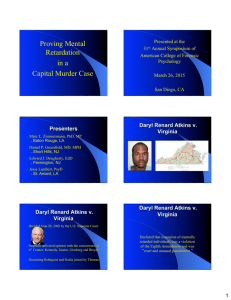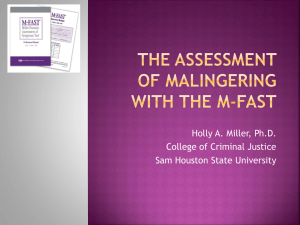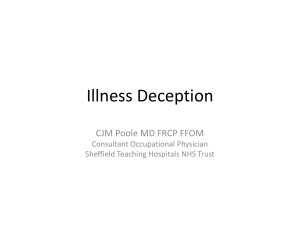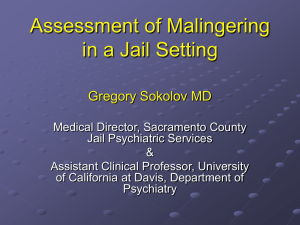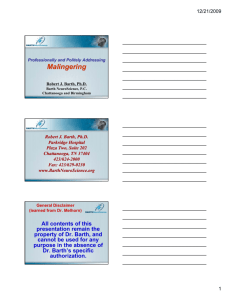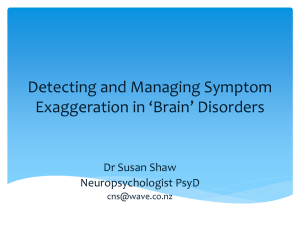MOG Physician Presentations 2014
advertisement
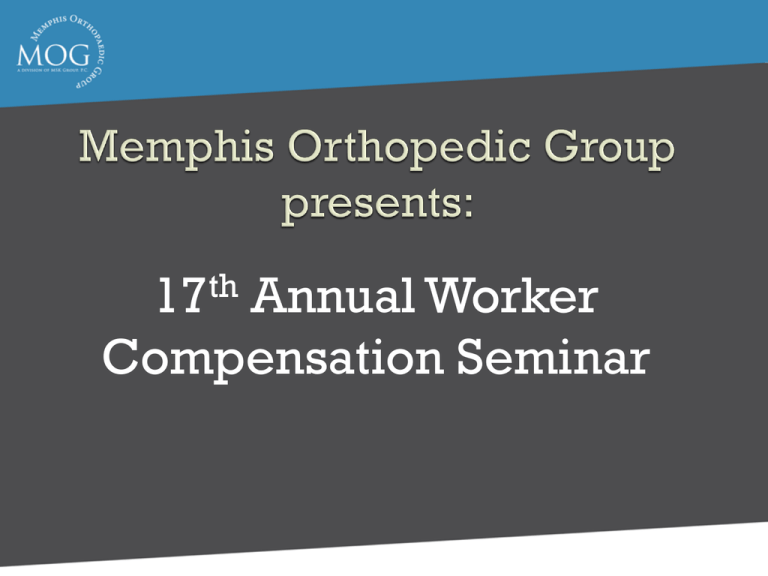
th 17 Annual Worker Compensation Seminar Please report any concerns or offenses taken to the COMPLIANCE OFFICER Dan Hein 901 756-0068 Email address: Dhein@mskgroup.org ROCKEFELLER Tennessee Workers’ Compensation Reform Jeff Francis Assistant Administrator Workers’ Compensation Division, Tennessee Department of Labor and Workforce Development A native of middle-Tennessee, Jeff received his B.B.A. degree in Marketing from Austin Peay State University in 1983 and his Master’s Degree in Labor Studies from the University of Massachusetts in 2000. As a Program Coordinator for the Tennessee Department of Labor and Workforce Development from 2004 until April 2008he developed and managed the Medical Impairment Rating Registry. He is now the Assistant Administrator of the Workers’ Compensation Division of the Tennessee Department of Labor and Workforce Development. His responsibilities include the budgeting, Human Resources, Information Systems, and Claims and Coverage aspects for the Division. He has been married to his college sweetheart for over 27 years. They have a married daughter teaching the third grade and a son who recently graduated from MTSU, who recently came off his dad’s payroll. Proximal Humerus Fractures: Evaluation and Management Malingering Kenneth A. Grinspun, MD MOG Work Comp Seminar April 16, 2014 Definition Prevalence Detection/Appreciation Treatment Strategies Bane of work comp! We all know it’s there, but what can we do about it? Why do patients malinger/magnify? How do we spot them earlier? How can we decrease the aggravation? How can we decrease costs? Proving malingering Confronting malingering The moment a malingerer is confronted, the traditional doctor patient relationship breaks down Treating malingering Staying on the same team IME’s, 2nd opinions... “Clinicians may be reluctant to address this behavior directly, even if there is strong evidence, because they are afraid of the consequences (e.g., mislabeling someone, being threatened, or being sued) [Binder & Iverson, 2000] Social media pushback Not much, just half a page! Use the term with caution Under normal circumstances the clinician rarely gets sufficient evidence for such definitive labeling Suggests using the term symptom magnification because its more clinically accurate and less likely to create disputes “The essential feature of malingering is the intentional production of false or grossly exaggerated physical or psychological symptoms, motivated by external incentives such as avoiding military duty, avoiding work, obtain financial compensation, evading criminal prosecution or obtaining drugs.” Symptom Magnification Unconscious Motivation Somatoform Conditions Schemas Factitious Disorders Other Physical Diagnoses Aging Missed Diagnosis Doctor Bias Malingering is defined as conscious motivation Unconscious motivation means patient is not entirely faking, but problems are not simply physical A lot like teenagers Capacity to cope with adversity Physical symptoms are not intentional Example: paralysis of limb High order abstraction of a person’s understanding Frequently wrong One study showed it’s the best predictor of RTW 94% RTW if good understanding 33% RTW if poor understanding Examples degenerative disc disease progression “I want to be 100% before I return to work” friends/family/attorney experiences with work comp and/or disability It reminds me of dealing with a teenager Strong conviction Questionable foundation Psychological (as opposed) to intentional motivation in order to assume the sick role Munchausen Pain associated with aging isn’t always gradual Arthritis does make people more susceptible to injury People may not be as “tough” as the used to be 1990’s TKA dissatisfaction - 10% 2010’2 TKA dissatisfaction - > 20% Job descriptions that are clearly not in line with a person’s age Getting old isn’t painless Difficult to distinguish pain from aging and work injury Fortunately, not very common Psychiatric patients can have medical problems MRI’s, nerve studies can be very helpful Work comp doctors vs. Attorney doctors Reluctance to be the “bad” guy Hoover Commission - 1993 California 20-30% of work comp claims are fraudulent cites financial incentives to fake injury/stress no objective measurements/testing 2009 Study - Prevalence of malingering for chronic pain in the context of a medico-legal setting with financial incentive 20-50% clinical diagnostic systems used AFL-CIO 2012 2% used malingering as the measurement “The reality of course is that no one knows what the real numbers are.” Surveillance Psychological Tests History Physical Examination Isokinetic Testing Possibly the only way to “prove” malingering Disadvantages expensive time consuming hard to catch someone “in the act” Many tests have been developed MMPI - Minnesota Multiphasic Personality Inventory TOMM - Test of Memory Malingering Opinions vary None are conclusive Based on probabilistic evidence Rare or bizarre symptoms Symptoms worsen or don’t improve with time/rest Symptoms begin after a latency period Multiple symptoms Hostility - “Why am I not getting better?” Drama - tears, family members present Friends/relatives with history of disability or having reaped financial benefit from claims Substance abuse, especially of prescribed analgesics and sedatives Attorneys Vague or implausible history Discrepancies in injury history/ inconsistent pain description Elaborate imagery to describe pain Emergency room visits Pain rated 9 or more out of 10 Symptom Proliferation Total Body Pain Unable to move legs/ collapsing/ sudden numbness Shaking Tears Blames life problems and mood on physical condition “I’ve worked all my life” (asserts former independence) Pain has changed entire life “I just want to get rid of the pain and get on with my life” “I fear I will be unable to work again” Has family member phone for medications (passive dependency) Patient angry at employer/ generally irritable Patient critical of previous doctor Symptoms worsen despite treatment and rest Setback as return to work date approaches Multiple return to date extensions Waddell’s signs skin tenderness simulation tests (pressing on the head) distraction testing regional disturbances exaggerated pain response Studies of Waddell’s signs One sign present in 47% of patient’s whose work status did not improve One sign present in 12% of patient’s whose work status did improve https://pdsmemphis.haikulearning.com/wmay/math2013-2014/cms_page/view/10802919 Strange limp Glove/stocking pain or numbness Give away weakness Variable grip Patient grabs examiners hand Perhaps the only test for malingering supported by empirical evidence Performed with a constant speed of angular motion but variable resistance Pre-employment physicals Some of these patients never should have been hired to do the job they are being asked to do Thorough history and exam Treat a diagnosis Avoid nebulous pain diagnosis Avoid suggesting an incorrect diagnosis Confirm diagnosis (MRI, EMG/NCS) Improved understanding of malingering vs. symptom magnification Be alert to signs/red flags Set expectations with the patient Address schemas as they arise Use exam and diagnostic tests Confirm (Isokinetics, second opinion) Accept that some unhappy resolutions are inevitable Call Email Lower Extremity Fractures ACL Injuries Christopher Ferguson, MD Memphis Orthopaedic Group ANTERIOR CRUCIATE LIGAMENT Primary restraint to preventing the tibia from “sliding forward” with knee motion Secondary restraint for “side bending” knee stability (varus/valgus stress) Valgus stress with tibial rotation Hyperextension of the knee Sudden direction change with weightbearing (“Cutting”) Contact sports History • Mechanism of injury • Reported knee instability Decreased ROM Swelling Instability on exam Anterior drawer test, Lachman’s test, Pivot shift Xray Findings • Usually normal • “Segond Fracture” Meniscal tears Articular cartilage injuries and bone contusions Collateral ligament injuries ACL, PCL, … (knee dislocations) Protect the knee • Meniscus (25% injury at 5 yrs w/o surgery) • Articular cartilage damage • Other ligaments Return to previous level of activity Rehab • Quad/hamstring strengthening • Proprioceptive training Bracing Timing of surgery Graft choice Surgical technique AUTOGRAFT Stronger More pain post op Increased surgical time Standard choice for younger patients ALLOGRAFT Less surgical time Less morbidity Faster rehab More expensive Higher failure rates Risk of infection AUTOGRAFTS ALLOGRAFTS • Patellar tendon • Patellar tendon • Hamstrings • Hamstrings • Quad tendon • Achilles • Ant/Post Tibialis • Quad tendon Patient selection Pre-op knee motion Placement of tunnels Appropriate graft selection Adequate fixation Rehab Patient compliance Poor ROM Arthrofibrosis Graft failure Persistent pain DVT Infection Early ROM Progress quickly to full weightbearing Quad and hamstring strengthening Return to full activity at approximately 6 months is common May take 18 months for knee function to maximize Good to excellent outcomes in > 90% of cases Less than 50% of athletes return to preinjury level of function Significant athletes risk of re-injury in young Thank you
